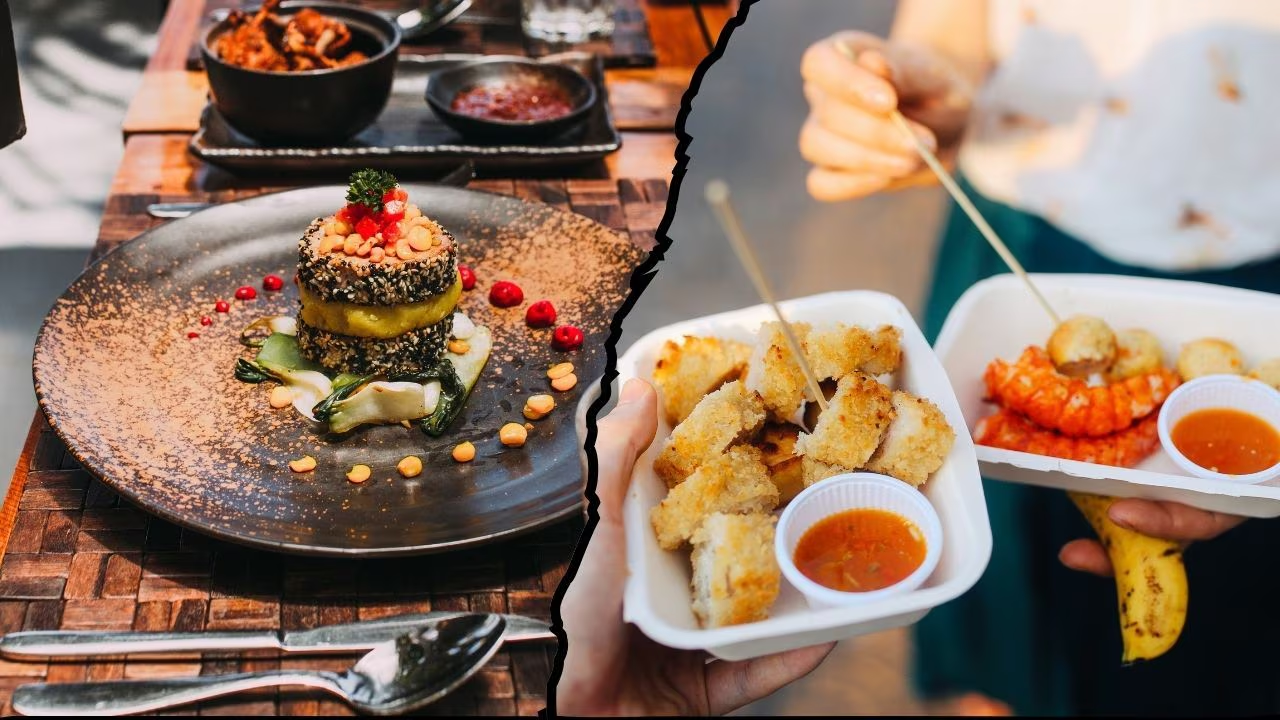Imagine stepping off a plane in the humid bustle of Bangkok, the air thick with the sizzle of pad Thai and the sweet tang of mango sticky rice. That was me a few years back, on my first solo trip through Southeast Asia, thinking I knew what good food tasted like. Boy, was I wrong. One bite into a street vendor’s som tam, that spicy papaya salad exploding with lime and chili, and I was hooked. Asia isn’t just a continent—it’s a feast for the senses, where every corner hides a culinary gem. From ancient recipes passed down generations to innovative fusions in gleaming skyscrapers, this region turns eating into an adventure. If you’re chasing flavors that linger long after the meal, these destinations will redefine your palate. Let’s dive in, one delicious stop at a time.
Why Asia is a Food Lover’s Paradise
Asia’s food scene thrives on diversity, blending influences from trade routes, migrations, and local ingenuity. Picture silk road spices mingling with fresh seafood from vast coastlines—it’s a melting pot that spans street stalls to Michelin-starred eateries. What sets it apart? Affordability meets authenticity; you can savor world-class dishes for pennies compared to Western spots. Plus, the communal vibe—sharing hot pots in Seoul or slurping noodles in Tokyo—builds connections that make every meal memorable.
Top Culinary Destinations in Asia
These spots aren’t just places to eat; they’re where food tells stories of history and culture. I’ve wandered markets at dawn and dined under stars, and trust me, each city has its own flavor profile that keeps you coming back.
Tokyo, Japan: Sushi and Beyond
Tokyo pulses with energy, home to more Michelin-starred restaurants than any city worldwide—194 as of 2025, making it a fine-dining powerhouse. But don’t overlook the izakayas and ramen shops where locals unwind. I once got lost in Tsukiji Market’s successor, Toyosu, sampling uni so fresh it melted like butter. It’s where tradition meets innovation, like kaiseki meals that feel like edible art.
- Must-try dishes: Sushi, ramen, tempura.
- Best spots: Tsukiji Outer Market for street eats; Sukiyabashi Jiro for iconic sushi.
- Pro tip: Hit conveyor-belt sushi for fun, budget-friendly bites.
Pros: Endless variety; high hygiene standards.
Cons: Can be pricey for top-tier spots; language barriers in smaller venues.
Bangkok, Thailand: Street Food Heaven
Bangkok’s chaotic charm shines in its night markets, where vendors whip up fiery tom yum goong and crispy roti. Ranked among the world’s best street food cities, it’s a sensory overload of sweet, sour, and spicy. On my trip, I braved a scorpion skewer at Chatuchak Market—tasted like crunchy chicken, surprisingly. The city’s food reflects Thai hospitality, blending royal recipes with everyday ingenuity.
- Must-try dishes: Pad Thai, green curry, mango sticky rice.
- Best spots: Yaowarat (Chinatown) for late-night feasts; Jay Fai for Michelin-starred street eats.
- Pro tip: Carry cash; most stalls are cash-only.
Pros: Incredibly affordable; vibrant atmosphere.
Cons: Traffic can make navigating tough; watch for spice levels if you’re sensitive.
Singapore: Hawker Centers and Fusion Flavors
Singapore’s clean, efficient vibe extends to its hawker centers, UNESCO-listed for cultural significance. Here, Chinese, Malay, and Indian influences collide in dishes like chili crab. I remember sweating through a plate at Maxwell Food Centre, the crab’s sweet-spicy sauce worth every messy finger. It’s a food democracy—Michelin stars at stalls for under $5.
- Must-try dishes: Hainanese chicken rice, laksa, roti prata.
- Best spots: Lau Pa Sat for satay; Tian Tian for chicken rice.
- Pro tip: Use the MRT to hop between centers easily.
Pros: Safe and hygienic; diverse options for all diets.
Cons: Humid weather can dampen outdoor dining; some spots get crowded.
Hong Kong: Dim Sum Delights
Hong Kong’s skyline mirrors its food scene—towering and dynamic, with dim sum as the star. Bite-sized har gow and siu mai in teahouses evoke old-world charm. During a rainy afternoon, I found solace in a yum cha session at Tim Ho Wan, the world’s cheapest Michelin-starred spot. It’s where Cantonese precision meets bold flavors, from roasted goose to egg tarts.
- Must-try dishes: Char siu bao, wonton noodles, pineapple buns.
- Best spots: Yum Cha for cute buns; Lung King Heen for upscale dim sum.
- Pro tip: Go early to avoid lines at popular spots.
Pros: Compact city for easy exploration; English widely spoken.
Cons: High costs in tourist areas; fast-paced crowds.
Seoul, South Korea: KBBQ and Kimchi
Seoul’s food pulses with fermentation and fire, from kimchi jjigae to sizzling bulgogi. Street tents in Myeongdong offer tteokbokki that warms you on chilly nights. I joined locals at a pojangmacha, grilling meats over charcoal while soju flowed—pure camaraderie. The city’s markets like Gwangjang burst with bibimbap and hotteok, blending ancient recipes with modern twists.
- Must-try dishes: Korean BBQ, bibimbap, samgyeopsal.
- Best spots: Gwangjang Market for street food; Jungsik for innovative Korean fine dining.
- Pro tip: Learn basic Korean phrases for better vendor interactions.
Pros: 24/7 food availability; tech-savvy ordering apps.
Cons: Spicy dominance might overwhelm mild palates; winter cold affects outdoor eats.
Penang, Malaysia: Multicultural Melange
Penang’s George Town is a UNESCO site for its architecture and food, fusing Malay, Chinese, and Indian tastes. Nasi lemak wrapped in banana leaves or char kway teow from hawker stalls—pure bliss. I cycled through streets, stopping for assam laksa that punched with sour fish broth. It’s affordable fusion at its best, with Peranakan influences adding unique spins.
- Must-try dishes: Char kway teow, roti canai, cendol.
- Best spots: Gurney Drive Hawker Centre; Line Clear for nasi kandar.
- Pro tip: Rent a bike to explore hidden stalls.
Pros: Budget-friendly; beachside vibes.
Cons: Monsoon rains can disrupt plans; less nightlife than bigger cities.
Hanoi, Vietnam: Pho and Freshness
Hanoi’s old quarter hums with pho vendors, their broth simmering for hours. Banh mi with French baguettes and Vietnamese fillings nod to colonial history. Sipping egg coffee by Hoan Kiem Lake, I watched the world go by—simple joys. The street food here is fresh, herbaceous, and unpretentious, perfect for adventurous eaters.
- Must-try dishes: Pho bo, bun cha, banh mi.
- Best spots: Pho Thin for classic pho; Banh Mi 25 for sandwiches.
- Pro tip: Cross streets confidently; traffic flows around you.
Pros: Super cheap; walkable old town.
Cons: Noisy scooters; variable hygiene in some areas.
Taipei, Taiwan: Night Market Nirvana
Taipei’s Shilin Night Market is a neon-lit wonderland of stinky tofu and oyster omelets. Bubble tea originated here, and I slurped countless variations. From xiao long bao at Din Tai Fung to beef noodles in alleys, it’s comfort food elevated. The city’s food mirrors its resilient spirit—humble yet flavorful.
- Must-try dishes: Beef noodle soup, scallion pancakes, bubble tea.
- Best spots: Raohe Street Night Market; Din Tai Fung for dumplings.
- Pro tip: Use EasyCard for seamless transport.
Pros: Safe for solo travelers; great vegetarian options.
Cons: Crowded markets; typhoon season disruptions.
Osaka, Japan: Kitchen of Japan
Osaka earns its “Japan’s Kitchen” title with okonomiyaki and takoyaki from Dotonbori stalls. Less polished than Tokyo, it’s raw and fun—I burned my tongue on hot takoyaki balls, laughing with locals. Kushikatsu skewers and kushiyaki grills add variety, all washed down with sake.
- Must-try dishes: Okonomiyaki, takoyaki, kushikatsu.
- Best spots: Kuromon Market; Daruma for skewers.
- Pro tip: Avoid double-dipping sauces; it’s a faux pas.
Pros: Friendlier vibe than Tokyo; cheaper eats.
Cons: Fewer English menus; humid summers.
Shanghai, China: Dumplings and Diversity
Shanghai’s skyline contrasts with its xiaolongbao stalls and hairy crab seasons. Yu Garden’s nanxiang dumplings burst with soup—pure magic on a cool evening. The city’s food fuses regional Chinese styles with international flair, from Sichuan spice to Shanghainese sweetness.
- Must-try dishes: Xiaolongbao, shengjianbao, hairy crab.
- Best spots: Jia Jia Tang Bao for dumplings; Ultraviolet for avant-garde dining.
- Pro tip: Use WeChat Pay for easy transactions.
Pros: Modern infrastructure; nightlife integration.
Cons: Pollution affects outdoor dining; visa hurdles for some.
Comparing Street Food vs. Fine Dining in Asia
To help decide your style, here’s a table breaking down key aspects across top cities:
| City | Street Food Highlights | Fine Dining Gems | Best For Budget Travelers? | Michelin Stars (2025) |
|---|---|---|---|---|
| Tokyo | Ramen alleys, onigiri stands | Kaiseki at Kanda | Moderate | 194 |
| Bangkok | Pad Thai carts, fruit shakes | Gaggan for Thai fusion | Yes | 34 |
| Singapore | Hawker laksa, satay | Odette for French-Asian | Yes | 52 |
| Hong Kong | Wonton noodles, egg waffles | Lung King Heen | Moderate | 71 |
| Seoul | Tteokbokki tents, hotteok | Mingles for modern Korean | Yes | 32 |
| Penang | Assam laksa, char kway teow | Auntie Gaik Lean’s for Peranakan | Yes | N/A |
| Hanoi | Pho sidewalks, bun cha grills | La Badiane for French-Vietnamese | Yes | N/A |
| Taipei | Night market stinky tofu | RAW for contemporary Taiwanese | Yes | 31 |
| Osaka | Takoyaki vendors, okonomiyaki | Hajime for innovative Japanese | Yes | 99 |
| Shanghai | Jianbing crepes, street dumplings | Ultraviolet for multi-sensory | Moderate | 48 |
This comparison shows Asia caters to all wallets—street food often rivals upscale in flavor, with cities like Bangkok shining for value.
Pros and Cons of Food-Focused Travel in Asia
Traveling for food in Asia is rewarding, but let’s weigh it out:
Pros:
- Cultural immersion through meals.
- Affordable compared to Europe or the US.
- Variety for dietary needs, like vegetarian in India-influenced spots.
- Social experiences, like group hot pots.
Cons:
- Potential stomach issues from unfamiliar spices—pack meds!
- Overcrowded markets during peaks.
- Language barriers in non-touristy areas.
- Ethical concerns with some street meats; opt for sustainable choices.
People Also Ask
Drawing from common queries on Google, here are real questions foodies ponder about Asia’s culinary scene, with straightforward answers.
What is the food capital of Asia?
Tokyo often claims this title for its Michelin dominance and endless variety, but Singapore and Bangkok vie for it with their accessible, diverse street scenes. It depends on your style—fine dining or casual bites.
Which country in Asia has the best food?
Thailand tops many lists for its balance of flavors, but Japan excels in precision and freshness. Personal fave? Vietnam for its herb-forward lightness.
What are the best street food cities in Southeast Asia?
Bangkok, Penang, and Hanoi lead, offering everything from spicy curries to fresh spring rolls in vibrant markets.
Where can I find Michelin-starred restaurants in Asia?
Tokyo, Hong Kong, and Singapore boast the most, with spots like Gaggan in Bangkok pushing boundaries.
Is Asian street food safe to eat?
Mostly yes, if you choose busy stalls with high turnover. Stick to cooked items and peelable fruits to minimize risks.
Informational: What is Asian Fusion Cuisine?
Asian fusion blends elements from multiple countries, like Korean tacos or Japanese-Italian pasta. It started in diaspora communities but now thrives in cities like Singapore, where chefs experiment boldly. It’s not traditional but evolves food cultures excitingly.
Navigational: Where to Get Authentic Street Food Tours
Book through platforms like Viator or local apps in Bangkok (e.g., Eat Like a Local tours) or Tokyo (Arigato Food Tours). For self-guided, head to apps like Google Maps with user reviews. Internal link: Check our guide to Asia’s markets [hypothetical: /asia-markets-guide].
Transactional: Best Tools for Foodie Travelers
Apps like HappyCow for vegans, TripAdvisor for reviews, or Translate for menus. For bookings, use Resy for fine dining or Klook for food tours. External link: Michelin Guide for stars (michelin.com).
FAQ
How do I avoid food poisoning in Asia?
Opt for busy vendors, drink bottled water, and get vaccinated. I always carry probiotics—saved me in Hanoi once.
What’s the cheapest food destination in Asia?
Bangkok or Hanoi, where meals cost $1-3. Penang’s close, with hawker plates under $2.
Are there vegetarian options in these cities?
Absolutely—Tokyo has shojin ryori, Bangkok’s jay food, and India’s influence in Singapore ensures plenty.
How many days should I spend in each city for food exploration?
3-5 days per spot; enough for markets, classes, and dinners without rushing.
What’s the best time to visit for food festivals?
Spring for cherry blossoms and picnics in Japan; fall for Mid-Autumn festivals in China with mooncakes.
In wrapping up, Asia’s food destinations aren’t just about eating—they’re about stories, like that late-night ramen in Tokyo that sparked a friendship or the Hanoi pho that warmed a rainy day. Whether you’re a street food junkie or a fine-dining aficionado, these spots deliver. Pack your appetite, an open mind, and maybe stretchy pants. Your next bite could be life-changing. Safe travels and happy eating!
(Word count: 2,756)



